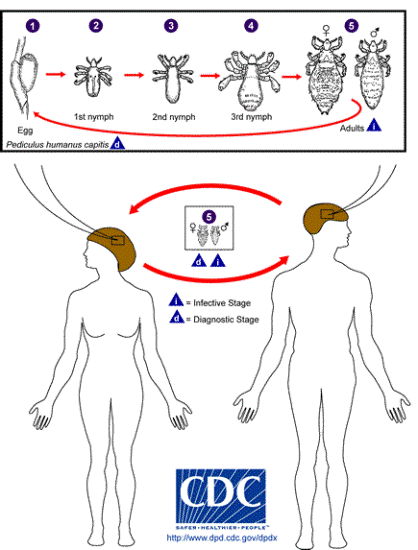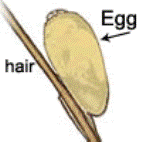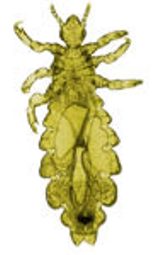|
The lifecycle of
Pediculus humanus can be quite rapid and exhibit only
sexual reproduction. This lifecycle contains three
stages: nit, nymph, and adult. For a single louse, the
lifecycle usually lasts 30 days.

 Stage
1- Eggs (also known as
nits): The adult females lay these nits, which are then
attached to the hair shaft by a gluey substance produced by
the louse. Nits range in color white to yellow, and
tan to gray, depending on the stage of the development and
whether or not they have been killed by a treatment or are
hatched. These eggs also obtain an oval or teardrop
shape. Stage
1- Eggs (also known as
nits): The adult females lay these nits, which are then
attached to the hair shaft by a gluey substance produced by
the louse. Nits range in color white to yellow, and
tan to gray, depending on the stage of the development and
whether or not they have been killed by a treatment or are
hatched. These eggs also obtain an oval or teardrop
shape.
 Stage 2 - Nymphs (immature louse):
The nits are usually found to incubate (sit upon for the
purpose of hatching) for seven to 14 days. Then, they
hatch to release the nymph. The nymph continues to
grow and mature for the next seven to ten days.
Throughout this period, the nymph goes through three molts
until it becomes an adult louse. Stage 2 - Nymphs (immature louse):
The nits are usually found to incubate (sit upon for the
purpose of hatching) for seven to 14 days. Then, they
hatch to release the nymph. The nymph continues to
grow and mature for the next seven to ten days.
Throughout this period, the nymph goes through three molts
until it becomes an adult louse.
 Stage 3 - Adults: The adult louse
has the lifespan of about 30 days and it the size of a
sesame seed. The adult louse needs to feed on
human
blood every three to six hours, and can not survive away
from the human host for more than approximately 24-36 hours.
The female is generally larger than the male and can lay
five nits per day. This means about 150 nits
throughout their lifespan! Stage 3 - Adults: The adult louse
has the lifespan of about 30 days and it the size of a
sesame seed. The adult louse needs to feed on
human
blood every three to six hours, and can not survive away
from the human host for more than approximately 24-36 hours.
The female is generally larger than the male and can lay
five nits per day. This means about 150 nits
throughout their lifespan!
As these insects reproduce,
the ideal temperature is about room temperature, give or
take a couple degrees. They are unable to reproduce in hot temperatures. This is why many
people suffering from head lice pour hot water on their head
and body. Lice are found to be repelled by the heat.
Good thing these critters only live
for about 30 days. Let's learn about the adaptations and
interactions that lice are associated with...
|



